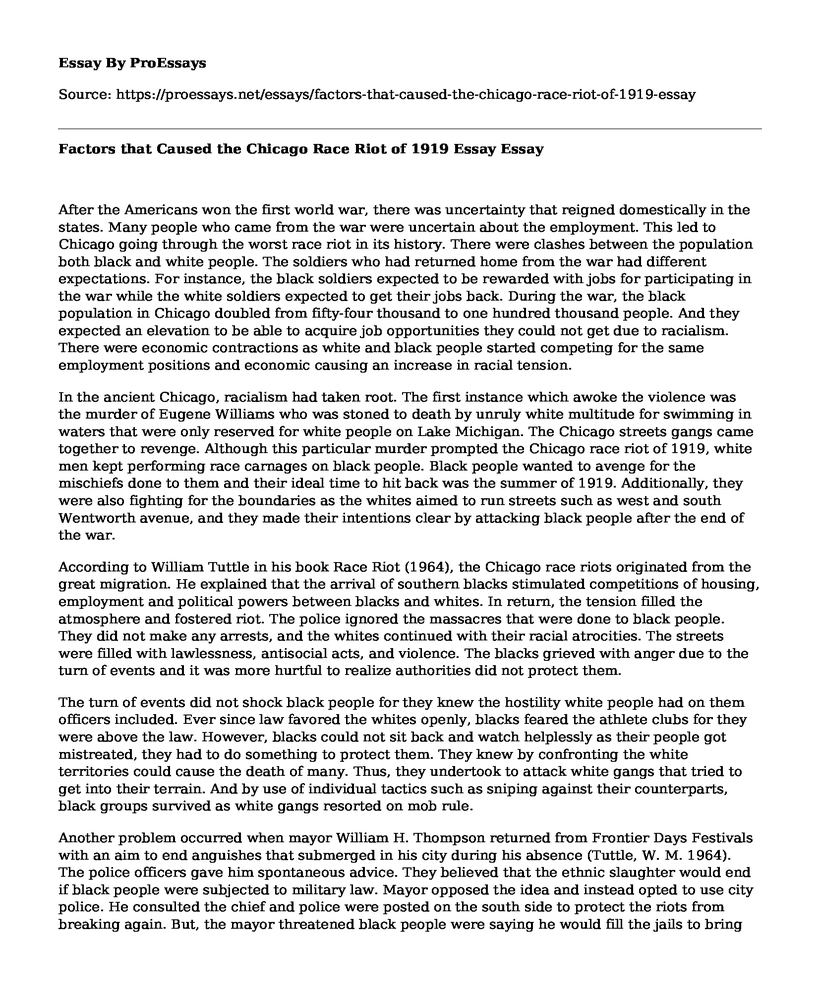After the Americans won the first world war, there was uncertainty that reigned domestically in the states. Many people who came from the war were uncertain about the employment. This led to Chicago going through the worst race riot in its history. There were clashes between the population both black and white people. The soldiers who had returned home from the war had different expectations. For instance, the black soldiers expected to be rewarded with jobs for participating in the war while the white soldiers expected to get their jobs back. During the war, the black population in Chicago doubled from fifty-four thousand to one hundred thousand people. And they expected an elevation to be able to acquire job opportunities they could not get due to racialism. There were economic contractions as white and black people started competing for the same employment positions and economic causing an increase in racial tension.
In the ancient Chicago, racialism had taken root. The first instance which awoke the violence was the murder of Eugene Williams who was stoned to death by unruly white multitude for swimming in waters that were only reserved for white people on Lake Michigan. The Chicago streets gangs came together to revenge. Although this particular murder prompted the Chicago race riot of 1919, white men kept performing race carnages on black people. Black people wanted to avenge for the mischiefs done to them and their ideal time to hit back was the summer of 1919. Additionally, they were also fighting for the boundaries as the whites aimed to run streets such as west and south Wentworth avenue, and they made their intentions clear by attacking black people after the end of the war.
According to William Tuttle in his book Race Riot (1964), the Chicago race riots originated from the great migration. He explained that the arrival of southern blacks stimulated competitions of housing, employment and political powers between blacks and whites. In return, the tension filled the atmosphere and fostered riot. The police ignored the massacres that were done to black people. They did not make any arrests, and the whites continued with their racial atrocities. The streets were filled with lawlessness, antisocial acts, and violence. The blacks grieved with anger due to the turn of events and it was more hurtful to realize authorities did not protect them.
The turn of events did not shock black people for they knew the hostility white people had on them officers included. Ever since law favored the whites openly, blacks feared the athlete clubs for they were above the law. However, blacks could not sit back and watch helplessly as their people got mistreated, they had to do something to protect them. They knew by confronting the white territories could cause the death of many. Thus, they undertook to attack white gangs that tried to get into their terrain. And by use of individual tactics such as sniping against their counterparts, black groups survived as white gangs resorted on mob rule.
Another problem occurred when mayor William H. Thompson returned from Frontier Days Festivals with an aim to end anguishes that submerged in his city during his absence (Tuttle, W. M. 1964). The police officers gave him spontaneous advice. They believed that the ethnic slaughter would end if black people were subjected to military law. Mayor opposed the idea and instead opted to use city police. He consulted the chief and police were posted on the south side to protect the riots from breaking again. But, the mayor threatened black people were saying he would fill the jails to bring race riot to an end. The resolution was not just for only one party was protected, and this promoted racial hatred and violence erupted once again.
Black people decreased in numbers enabling the white gangs to take upon them. They ran after them with all types of crude weapons and killed them. The streets turned chaotic as the blacks also hit back with their sniper tactics. Since rumors about the death of many black people spread fast, tension continued to grow prompting retaliation. The black people confronted the whites making them feel threatened. The white gangs invaded the territories of black people killing everyone. On the other hand, blacks organized riot which white people found hard to scatter since as the riots worsened trains stopped running posing danger to white people who crossed the neighborhood to work. The sarcasm of these riots was that justice was single sided.
Conclusion
To sum up, it is clear that racial discrimination started many years ago and affected many parts of the United States. However, Chicago had the worst experience that leads to the race riot. The race riot caused the death of many while others were left homeless and wounded. The situation worsened when authorities took sides protecting one race rather than serving justice to its mixed population. Additionally, we see the power of unit as the black gangs joined together, they were able to arise to a well-organized riot which whites feared and ended the riot.
Reference
Tuttle, W. M. (1964). The Chicago Race Riot of 1919. University of Wisconsin--Madison.
Cite this page
Factors that Caused the Chicago Race Riot of 1919 Essay. (2022, Aug 23). Retrieved from https://proessays.net/essays/factors-that-caused-the-chicago-race-riot-of-1919-essay
If you are the original author of this essay and no longer wish to have it published on the ProEssays website, please click below to request its removal:
- Reasons for the Fall of The Roman Empire
- What Lead To The Civil War And How It Was Won? - Essay Sample
- Essay Sample on History of American People
- Colonial Powers Clashed in America: France, England, Spain - Research Paper
- Adolf Hitler: Nazi Leader, Strategist, Anti-Semite - Essay Sample
- Essay Example on the Causes of Civil War in Antebellum America
- Article Analysis Essay on Slavery and Abolition in the 20th Century







